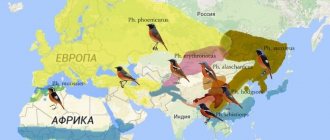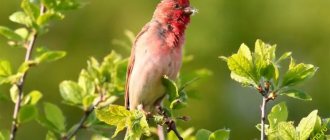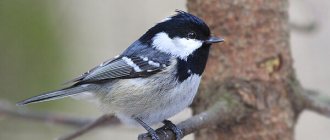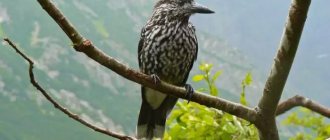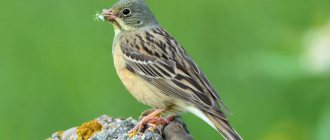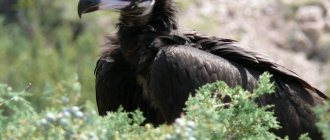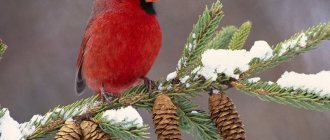Description and features
The Karavaika is a medium-sized bird. The body on average is about 55-56 cm long, the wingspan is from 85 to 105 cm, the length of the wing itself is about 25-30 cm. The weight of the bird can be from 500 g to 1 kg.
They, like all ibises, have a fairly long beak, although it looks even thinner and more curved than those of other relatives. Actually, the Latin name Plegadis falcinellus means “sickle-shaped”, and refers specifically to the shape of the beak.
The body is strongly built, the head is small, and the neck is moderately long. The legs are leathery and without feathers, which is common among stork birds. The loaf's limbs are considered to be of medium length. The main difference from ibises is the more advanced structure of the tarsus (one of the leg bones between the shin and toes).
It helps to land softer, as it perfectly absorbs the landing. In addition, thanks to it the bird makes a good push when taking off. In addition, thanks to it, the bird balances more confidently on tree branches. A kind of “spring” of natural origin.
Our heroine’s wings are wider than those of other members of the family, and also rounded at the edges. The tail is quite short. Finally, the main distinguishing feature is the color of the plumage. The feathers are thick and located throughout the body.
On the neck, belly, sides and upper part of the wings they are colored a complex chestnut-brown-red color. The feathers on the back and back of the body, including the tail, are black. Perhaps this is how it got its name. It’s just that over time, the Turkic word “karabaj” (“black stork”) changed to the more affectionate and familiar to us “loaf”.
In the sun, the feathers shimmer with a rainbow tint, acquiring an almost bronze metallic sheen, for which the bird is sometimes called the glossy ibis. In the eye area there is a small area of bare gray skin in the shape of a triangle, bordered at the edges by white strokes. The legs and beak are a dull pinkish-gray shade, the eyes are brown.
Closer to autumn, the loaf in the photo looks slightly different. The metallic sheen on the feathers disappears, but small white specks appear on the neck and head. By the way, young birds look almost the same - their entire body is dotted with such streaks, and their feathers are distinguished by a matte brown tint. With age, the speckles disappear and the feathers become iridescent.
This bird is usually quiet and silent, and is rarely heard outside its breeding colonies. At the nest they make sounds similar to a dull croak or hiss. The singing of a loaf , just like the roulades of a peacock, is unpleasant to the ear. Rather, it sounds like the creaking of an ungreased cart.
Kinds
The genus of loonies includes three species - ordinary, spectacled and slender-billed.
- The spectacled loaf is a resident of the North American continent. It mainly occupies the western part of the United States, southeastern Brazil and Bolivia, and also occurs in the central part of Argentina and Chile. It has the same brownish-purple plumage with a metallic sheen. Differs from the usual area around the beak, which is painted white.
- The slender-billed loon or Ridgway's loon is a native of South America. There are no special differences in plumage either. It is distinguished from a typical representative by the reddish tint of its beak. She probably got the name for its more noticeable appearance.
It is impossible to ignore our heroine’s close relatives – ibises. In general, there are about 30 species. The white and red ibises are considered to be the closest to the loaf.
- The red ibis has a very beautiful plumage of bright scarlet color. It is slightly larger in size than a regular loaf. Lives in South America. Before the mating season, birds grow throat pouches.
- The white ibis is also an inhabitant of the American continent. The plumage, as you know, is snow-white; on the front of the head there are red areas without feathers. Only at the tips of the wings are there black edges, noticeable only in flight. Long legs and a slightly curved beak are painted in a bright orange color almost all year round.
- And finally, the most famous relative of the loaf - the sacred ibis. It got its name in Ancient Egypt. He was considered the personification of the god of wisdom Thoth, and therefore he was embalmed for preservation more often than other birds.
The main plumage is white. The head, neck, wing tips, beak and legs are black. The most beautiful bird looks in flight - a white glider with a black border. Body size is about 75 cm. Today, such an ibis can be found in North Africa, Australia and Iraq.
In Russia, arrivals of this bird were previously observed in Kalmykia and the Astrakhan region. For some reason, we usually call it black loaf , although this contradicts its appearance.
Lifestyle and habitat
The karavaik can be called rather a heat-loving bird. Its nesting sites are located in separate areas on the African continent, in the west and south of Eurasia, in Australia and in the southeast of the USA. In Russia, it is found in river basins that carry their waters to the Black, Caspian and Azov Seas. Migratory individuals winter in Africa and Indochina.
And the few wintering birds remain near their own family nests. They live in colonies, often adjacent to other similar birds - herons, spoonbills and cormorants. They usually live in pairs. All nests are located in hard-to-reach places, on tree branches or in impenetrable bushes.
For example, African representatives choose for this purpose a very prickly species of mimosa, which the Arabs call “harazi” - “protecting themselves.” From the thickets and branches the nest appears like a deep, loose structure, reminiscent of an openwork bowl.
It happens that little louses take over the nests of others, for example, night herons or other herons, but then they rebuild them anyway. The most comfortable conditions for them are the banks of reservoirs or swampy lowlands.
They lead a very active lifestyle. The bird can rarely be seen standing motionless; usually it paces through the swamp, diligently finding food for itself. Only occasionally does he sit down to rest on a tree.
It flies rarely, most often due to imminent danger or for the winter. In flight, the bird extends its neck, like a crane, and makes intense flapping of its wings, which alternate with smooth gliding through the air.
Migration
The species is classified as a “weather immigrant.” This means that the period of return of the feathered representative from the wintering grounds depends on the weather conditions in the nesting areas. For example, in Eurasia, in different years, the return of the species was noted from the beginning of spring to the beginning of summer. Also, the arrival of individual flocks of birds does not occur at one time.
The feathered representative prefers to migrate in the early morning hours.
Nutrition
In terms of food, the loaf is not picky; it uses both plant and animal food. On land, it deftly finds bugs and worms, larvae, butterflies, and seeds of some plants. And in the reservoir it feeds on tadpoles, small fish, frogs, and snakes.
The lobster with a long beak is simply an ideal bottom scout. Favorite delicacy is crustaceans. Plant food is represented by algae. Interestingly, males prefer to eat insects, while females prefer snails.
Sometimes it hunts near fishing grounds and residential settlements, catching fry of farmed fish. Usually the diet is influenced by the time of year - if a large number of frogs appear, preference is given to them. When there is a dominance of insects, for example, locusts, birds focus on them.
Wintering
The bulk of the Eurasian population flies through Greece to eastern Africa for the winter. A smaller part flies through Italy and France, trying to get to the territory of northern and western Africa.
Azerbaijanis are also flying to East Africa.
The species rarely spends the winter in subtropical regions of southern Europe, as well as in Azerbaijan.
Reproduction and lifespan
Future parents begin building the nest in the second half of March. Both birds take part in this process. The starting material is branches, reeds, leaves and grass. The size of the building is impressive - up to half a meter in diameter, and almost ideally cup-shaped.
The depth of this structure is about 10 cm; it is usually located somewhere on a bush or tree, which additionally protects against attacks by natural enemies. There are 3-4 eggs in a clutch of a delicate bluish-green hue. They are mainly hatched by the mother. At this time, the parent is engaged in guarding, obtaining food, only occasionally replacing his friend on the clutch.
The chicks appear after 18-20 days. They are initially covered with black down and have a sparse appetite. Parents have to feed them 8-10 times a day. Over time, the appetite fades, and the fluff wears off, turning into feathers.
They make their first flight at the age of 3 weeks. After another seven days, they can already fly on their own. Typically, the life expectancy of ibises is about 15-20 years. But this period is greatly influenced by natural conditions and the presence of natural enemies.
Chicks
At the age of 2-3 weeks, the young are already walking near the nest. The chicks remain in or close to the nest for four to five weeks, fed by both parents. The first attempt to take off occurs after the cubs reach 4-5 weeks. Later, they feed with their parents during the day and sleep with them late at night, sharing trees with other species of ibis, spoonbills and herons.
Natural enemies
In nature, the loaf has many enemies, but they do not come across it so often. The inaccessibility of habitat has its effect. Most often they compete with hooded crows. They rob waterfowl in their territory, taking food and destroying nests. In addition, any bird of prey or nimble animal can harm the loon.
But it is man who causes her special damage. Due to irrigation works, birds often lose their homes. During spring floods, nests are flooded. Clutches often die when the reeds are burned. Man hunts poultry because its meat is quite tasty.
However, it is of greatest value for zoos. The bird quickly gets used to captivity and pleases with its appearance and rare intelligence. At the moment, the loaf is listed in the Red Book of Russia as a species under threat. After all, there are less than 10 thousand pairs of these beautiful birds left.
Loaf in the Red Book
The number of the species is decreasing every year. If in the middle of the nineteenth century representatives of the species could be found everywhere, then at the beginning of the twentieth the number gradually began to decrease.
Main causes of extinction
After human development of wetlands, water withdrawal for irrigation, and regulation of river flows led to a reduction in habitat area.
The reduction of nesting biotas due to rice crops, as well as fishing, has led to birds leaving their nests. Of particular danger is setting fire to reed beds, where the common loon loves to nest.
Representatives also die as a result of collisions with power lines, from attacks by predators, as well as fluctuations in water levels.
Current population situation
The world population numbers from sixty to one hundred thousand individuals. According to research results, in the early nineties, about 22 thousand pairs constantly nested in Europe alone, but now the number of pairs has decreased to 15-20 thousand.
Are protective measures required?
Places where the ibex can nest are gradually dried out or planted with rice. As a result, birds often leave their homes, or even leave ready-made nests. All this leads to a gradual decline in the population.
Birds also often die from floods and even from human hands. To avoid the destruction of this species, it is worth creating nature reserves and limiting agricultural activities in areas of suspected nesting.
Interesting Facts
- In the old days, people believed that loafs were spirit birds. It’s as if they fly only at night, fast as shot from a gun. They can only be seen by shooting, aiming at random at the entire flock. In addition, there was a legend that they lay eggs right in the clouds.
- It is ibises, including ibises, that are considered birds that predict river floods. Since ancient times, they have appeared on the banks of deep rivers closer to dangerous high waters. Residents of coastal areas knew this feature well, and often left to higher ground ahead of time along with livestock and things.
- Herodotus believed that ibis birds track down the nests of snakes, kill them, and therefore are very popular in Egypt. Moreover, there was a legend that they are not afraid even of dragons and other reptiles. However, despite the apparent fictionality of the last assumption, we should not forget that the Egyptians usually deified animals that benefited them. So the background to this legend is very plausible - ibises really hunt small snakes.
